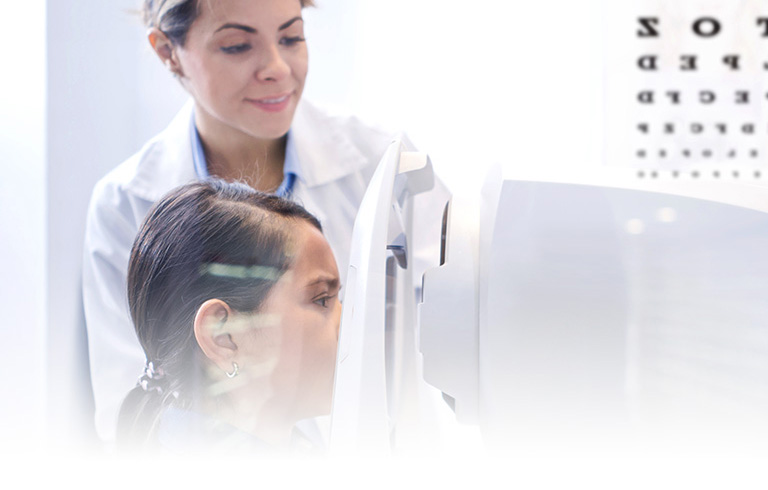
Module 3
SELECTION & EXAMINATION
At the end of this module, you should be able to:
- Identify ideal and challenging candidates for Euclid Ortho-K lenses
- Describe the contraindications for Euclid lenses
- Outline the data required at the initial examination of a patient being fitted with Euclid lenses
- List the examination data needed to order a Euclid lens
Ideal Candidates for Orthokeratology (1/7)
One of the most important steps for success with Euclid Ortho-K lenses is selecting the right candidate for treatment. Ideal candidates are:
- Patients with myopia between -1.00 and -5.00 diopters (While lower myopes below 1.00D are still candidates for the Euclid lens, the best results of correction and holding time are achieved with patients with slightly higher refractive error.)
- Patients with astigmatism less than -1.50 diopters WTR or -0.75 diopters ATR
- Patients with eccentricity values of 0.3 to 0.7
- Patients with flat keratometry readings between 8.44mm (40.00D) and 7.34mm (46.00D)
- Patients with a corneal diameter greater than 11.0mm
There are no age restrictions for Euclid overnight orthokeratology wear in the US.
Challenging Candidates for Orthokeratology (2/7)
Patients with the following parameters would not be ideal candidates for Euclid lenses.
- Myopia greater than -5.00 diopters
- Euclid lenses are approved by the FDA to treat myopia up to -5.00 diopters
- Refractive astigmatism greater than
- -1.50 diopters WTR (FDA approval limit for refractive astigmatism)
- -0.75 diopters ATR
- Greater than or equal to 50% of the sphere power (i.e. -0.50-1.50X180)
- Patients with astigmatism greater than 50% of the sphere power may experience residual astigmatism
- Patients with large, flat corneas (Flat K <40.00, HVID >12.5)
- Patients with large, flat corneas tend to respond more slowly to Ortho-K treatment and may experience issues with lens decentration
- Patients with steep corneas (Flat K >46.00)
- Patients with steeper corneas may experience issues with lens decentration
- Patients with large pupils (greater than 6mm in dim illumination)
- Patients with large pupils may experience side effects of haloes and glare, as the treatment zone may not be large enough to cover their pupil, especially in dim illumination
- Patients with small corneas (HVID <11.0)
- Patients with small corneas may not be able to safely wear larger lenses without impinging on the limbus. While lenses can be made slightly smaller for an initial fit if necessary, the required Ortho-K lens curves cannot be manufactured on lenses smaller than 9.8 mm.
Ideal Patients for the Euclid Toric Design (3/7)
Patients with limbus to limbus astigmatism and corneal elevation differences between the flat and steep meridian at a chord of 8mm that are greater than 25 microns are good candidates for the Euclid MAX Toric and Euclid Emerald Toric designs. Only the corneal elevation component of astigmatism is impacted by orthokeratology posterior toricity treatment.
Contraindications (4/7)
Patients with any of the following conditions should not be fit with Euclid Ortho-K lenses:
- Active corneal infections, acute/subacute inflammation of the anterior chamber
- Disease, injury, or any abnormality affecting the cornea, conjunctiva, or eyelids
- Severe dry eyes
- Corneal hypoesthesia
- Any condition exacerbated by contact lens wear
- Allergy to any ingredient in lens care solutions
- IOP outside of normal range
Initial Examination (5/7)
Once you’ve determined that your patient is a good fit for Euclid Ortho-K lenses, a standard eye exam should give you all the tools you need.
Instrumentation Needed:
- Keratometer (Auto, Manual, SimK) for K readings
- Corneal topographer for screening and baseline record
- Phoropter or autorefractor
- Slit lamp (Yellow Wratten filter recommended)
Be sure to capture the following:
- HVID
- Pupil size in dim light
- Dry eye data
- Baseline (pre-treatment) topography (if available)
Lens Ordering (6/7)
Thanks to the power of three factor fitting, all you need to provide to your Euclid consultant are the following parameters:
- Rx
- K’s
- HVID
These three pieces of information are factored into Euclid’s proprietary algorithm to produce a Euclid Ortho-K lens specifically designed for your patient’s eyes.
Summary (7/7)
In this module, we discussed:
- Ideal candidates for Euclid Ortho-K lenses will have less than 5.00 diopters of myopia, less than 1.50 diopters of astigmatism, and a corneal diameter greater than 11.00mm
- Challenging candidates will have more than 5.00 diopters of myopia, 1.50 diopters of astigmatism, or large pupils
- Corneal infections, diseases, severe dry eyes, and an IOP outside of the normal range are all contraindications for Euclid lenses
- Ideal candidates for Euclid Toric lenses have limbus to limbus astigmatism and more than 25 microns of sag height difference between the primary meridians
- To order a Euclid lens, simply provide your consultant with Rx, K’s and HVID (When ordering Euclid Toric lenses, please have the sag height difference available to receive the correct amount of toricity on the lenses.)



